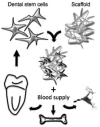Tissue engineering: from research to dental clinics
- PMID: 22240278
- PMCID: PMC3727423
- DOI: 10.1016/j.dental.2011.11.025
Tissue engineering: from research to dental clinics
Abstract
Tissue engineering is an interdisciplinary field that combines the principles of engineering, material and biological sciences toward the development of therapeutic strategies and biological substitutes that restore, maintain, replace or improve biological functions. The association of biomaterials, stem cells, growth and differentiation factors has yielded the development of new treatment opportunities in most of the biomedical areas, including Dentistry. The objective of this paper is to present the principles underlying tissue engineering and the current scenario, the challenges and the perspectives of this area in Dentistry.
Significance: The growth of tissue engineering as a research field has provided a novel set of therapeutic strategies for biomedical applications. Indeed, tissue engineering may lead to new strategies for the clinical management of patients with dental and craniofacial needs in the future.
Copyright © 2011 Academy of Dental Materials. Published by Elsevier Ltd. All rights reserved.
Figures



References
-
- Majumdar SK. History of dentistry: an overview. Bull Indian Inst Hist Med Hyderabad. 2002;32:31–42. - PubMed
-
- Nör JE. Tooth regeneration in operative dentistry. Oper Dent. 2006;31:633–642. - PubMed
-
- Hohlfeld J, de Buys Roessingh A, Hirt-Burri N, Chaubert P, Gerber S, Scaletta C, Hohlfeld P, Applegate LA. Tissue engineered fetal skin constructs for paediatric burns. Lancet. 2005;366:840–842. - PubMed
-
- Warnke PH, Springer IN, Wiltfang J, Acil Y, Eufinger H, Wehmoller M, Russo PA, Bolte H, Sherry E, Behrens E, Terheyden H. Growth and transplantation of a custom vascularised bone graft in a man. Lancet. 2004;364:766–770. - PubMed
-
- Niklason LE, Gao J, Abbott WM, Hirschi KK, Houser S, Marini R, Langer R. Functional arteries grown in vitro. Science. 1999;284:489–493. - PubMed
Publication types
MeSH terms
Substances
Grants and funding
LinkOut - more resources
Full Text Sources

